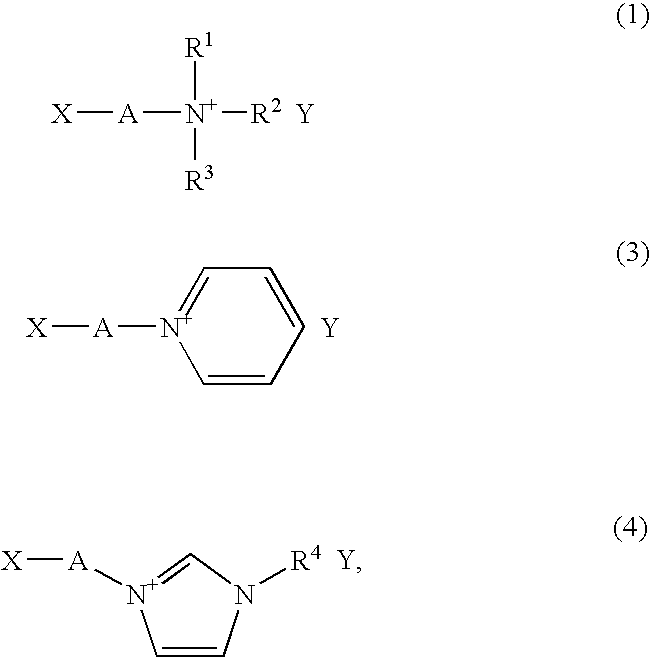Liquid composition containing no solvent
a liquid composition and solvent technology, applied in the direction of non-macromolecular adhesive additives, other chemical processes, coatings, etc., can solve the problems of compromising the versatility of the adhesive, affecting human health, and affecting the effect of solvent evaporation, so as to prevent the adverse effects of solvent evaporation on human health and the environment, and simplify the overall work involved in adhesive bonding and coating
- Summary
- Abstract
- Description
- Claims
- Application Information
AI Technical Summary
Benefits of technology
Problems solved by technology
Method used
Image
Examples
synthesis example 1
Synthesis of Polymerizable Group-Bearing Ionic Liquid (6)
[0093] A solution was prepared by dissolving 11.7 g of N,N-diethylaminoethyl methacrylate (Wako Pure Chemical Industries, Ltd.) in 250 ml of tetrahydrofuran (Wako Pure Chemical Industries), then stirred with a stirrer under ice cooling while slowly adding 4.71 ml of iodomethane (Sigma-Aldrich Japan KK). After 30 minutes, the ice bath was removed and stirring was continued overnight at room temperature. The solvent in this reaction solution was driven off by vacuum distillation, and the resulting solids were recrystallized from an ethanol (Wako Pure Chemical Industries) - tetrahydrofuran mixture, yielding 18.17 g of N,N-diethyl-N-methyl-N-(2-methacryloylethyl)ammonium iodide.
[0094] Next, the 18.17 g of the N,N-diethyl-N-methyl-N-(2-methacryloylethyl) ammonium iodide was dissolved in 50 ml of acetonitrile (Kanto Chemical Co., Inc.), following which 15.93 g of lithium bis(trifluoromethanesulfonyl)imide (Kanto Chemical) was add...
synthesis example 2
Synthesis of Polymerizable Group-Bearing Ionic Liquid (9)
[0095] A solution was prepared by dissolving 10.0 g of N-(2-acryloylethyl)-N,N,N-trimethylammonium chloride (Kohjin Co., Ltd.), prepared as a 79 wt % aqueous solution, in 50 ml of ion-exchanged water. Next, 11.72 g of lithium bis(trifluoromethanesulfonyl)imide (Kanto Chemical) was added and the mixture was stirred for 60 minutes. Of the two distinct phases that formed, the organic phase was separated off and collected.
[0096] A suitable amount of ion-exchanged water was added to the organic phase and washing was carried out, thereby removing impurities from the organic phase. After washing, residual moisture was removed from the organic phase with a vacuum pump, yielding 16.27 g of a polymerizable group-bearing ionic liquid (9).
synthesis example 3
Synthesis of Polymerizable Group-Bearing Ionic Liquid (10)
[0097] A solution was prepared by dissolving 7.15 g of N,N-dimethylaminoethyl acrylate (Kohjin Co., Ltd.) in 50 ml of tetrahydrofuran (Wako Pure Chemical Industries), then stirred with a stirrer under ice cooling while slowly adding 7.80 ml of iodoethane (Wako Pure Chemical Industries). After 30 minutes, the ice bath was removed and stirring was continued overnight at room temperature. The solvent in this reaction solution was driven off by vacuum distillation, and the resulting solids were recrystallized from an ethanol-tetrahydrofuran mixture, giving 12.23 g of N-(2-acryloylethyl)-N-ethyl-N,N-dimethylammonium iodide.
[0098] Next, the 12.23 g of N-(2-acryloylethyl)-N-ethyl-N,N-dimethylammonium iodide was dissolved in 50 ml of ion-exchanged water, following which 11.74 g of lithium bis(trifluoromethanesulfonyl)imide was added and the mixture was stirred for 60 minutes. Of the two distinct phases that formed, the organic pha...
PUM
| Property | Measurement | Unit |
|---|---|---|
| size | aaaaa | aaaaa |
| size | aaaaa | aaaaa |
| thickness | aaaaa | aaaaa |
Abstract
Description
Claims
Application Information
 Login to View More
Login to View More - R&D
- Intellectual Property
- Life Sciences
- Materials
- Tech Scout
- Unparalleled Data Quality
- Higher Quality Content
- 60% Fewer Hallucinations
Browse by: Latest US Patents, China's latest patents, Technical Efficacy Thesaurus, Application Domain, Technology Topic, Popular Technical Reports.
© 2025 PatSnap. All rights reserved.Legal|Privacy policy|Modern Slavery Act Transparency Statement|Sitemap|About US| Contact US: help@patsnap.com



